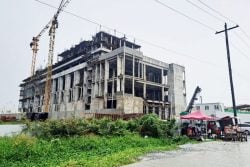(Barbados Nation) The Queen Elizabeth Hospital is gearing up to introduce a new electronically driven information system within the next few months at its Accident & Emergency Department (A& E) which could lead to significantly reduced wait times at this island’s largest medical health facility.
In his first interview since taking up the top post at the Queen Elizabeth Hospital (QEH), chief executive officer Neil Clarke revealed the plans for the system he hopes will reduce the nagging and frustrating long wait times at the A& E.
Clarke said the QEH was putting together a tender offer for the special IT system which would better inform doctors when surges of patients within the A& E Department were expected, the number of patients involved, and where resources would be best placed. He hopes the system will be in place within the next few months.
In recent years, the QEH established a new triage system and increased human resources within the beleaguered department but long wait times for non-emergency patient care continue to be a bugbear.
Clarke is hoping the new health information system would provide a remedy to cure the Accident & Emergency Department of this issue which has frequently evoked the ire of many Barbadians who speak out about their experiences when they have sought treatment for themselves or others.
He revealed the QEH was hoping to have that system tendered out for this summer and a provider identified as soon as possible.
“That system would link together all the departments in the hospital and we would work with the vendor to identify the roll-out,” he added.
Clarke said there were international providers of such systems specifically geared for health care facilities, adding that the QEH had already started to look at what types were available in the Caribbean and nearby jurisdictions.
Challenges
“We don’t have many information systems in the hospital and we need to automatically capture information to pre-warn us that the number of patients in the A& E is higher than normal. We have a system which isn’t providing the information that I would have hoped. It tracks patients but isn’t providing the information that I would want to see from it,” said Clarke.
He said the hospital must find a system which does not take away doctors or nurses from the work they should be doing.
“The (other) systems in the A& E are the right systems,” Clarke admitted. “. . . But the challenges are beyond that. In a normal working day, they will manage well, but if there is a surge of activity that creates a problem, we need to better understand how we respond to those surges.”
Clarke noted that overall, consultations were already taking place with a view to have quick improvements in the A& E Department.
“We’ve already started the work to review the pathways in A& E. We’re reviewing escalations, what they (staff) need to do at different points so that when it’s getting busy and we have peaks and surges, how do you manage that surge, and what we can do differently during the surge,” he said in the interview with the DAILY NATION.
Clarke said in his eight weeks on the job, the acute challenges in A& E had been identified.
“There is a challenge with the A& E waiting times. We need to expedite that forward quickly. We first have to find out why people come to the department and what’s available to them. And for those who have had an accident and it’s a clear emergency, not a long-term illness, how they can get treatment faster,” Clarke said while speaking at his office at the Martindale’s Road, St Michael, facility.




